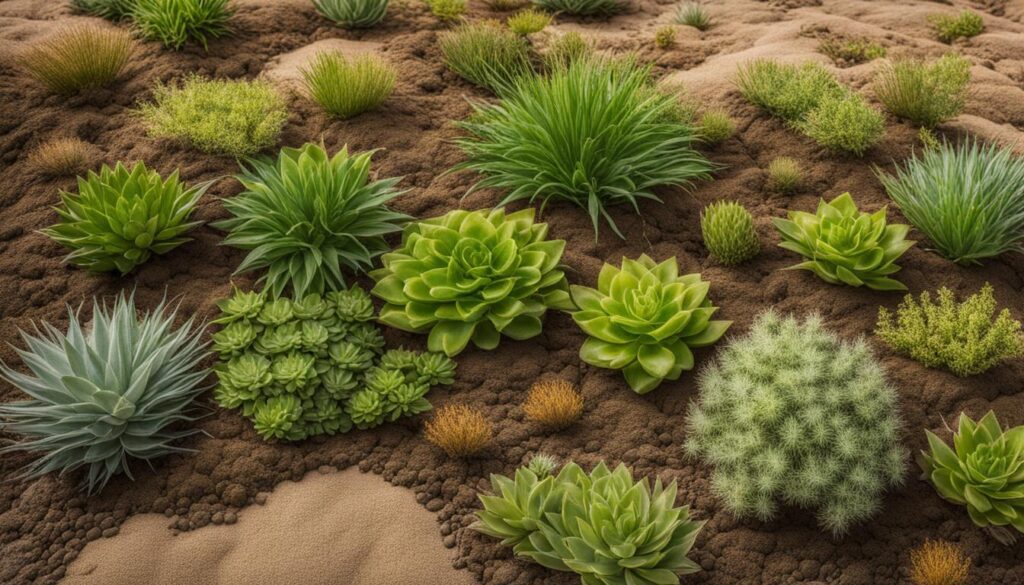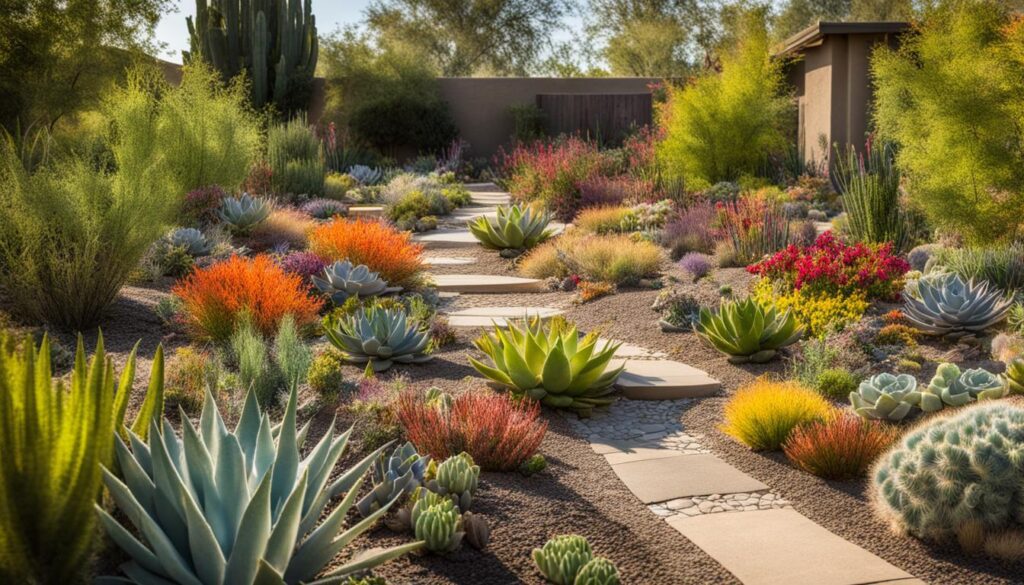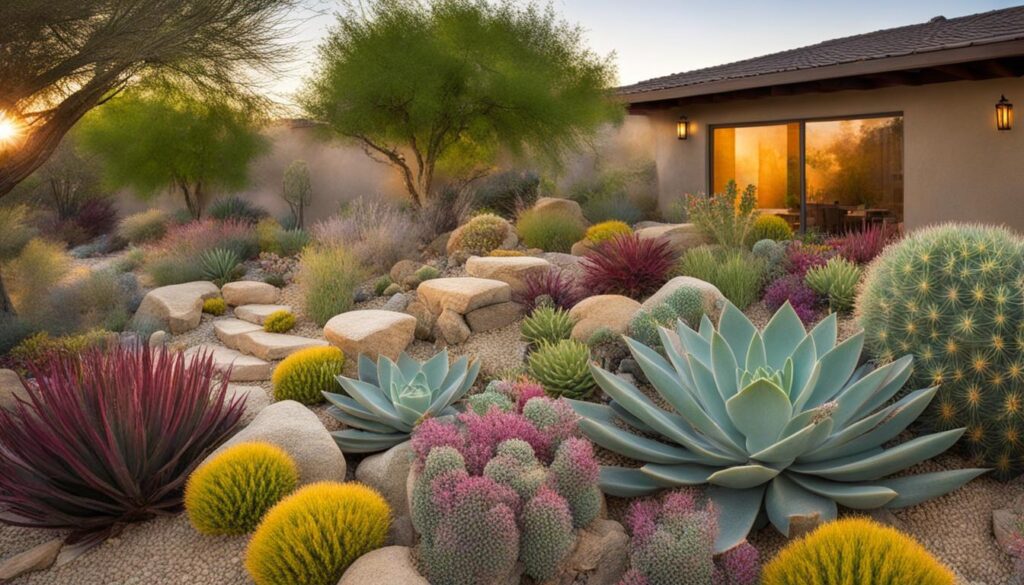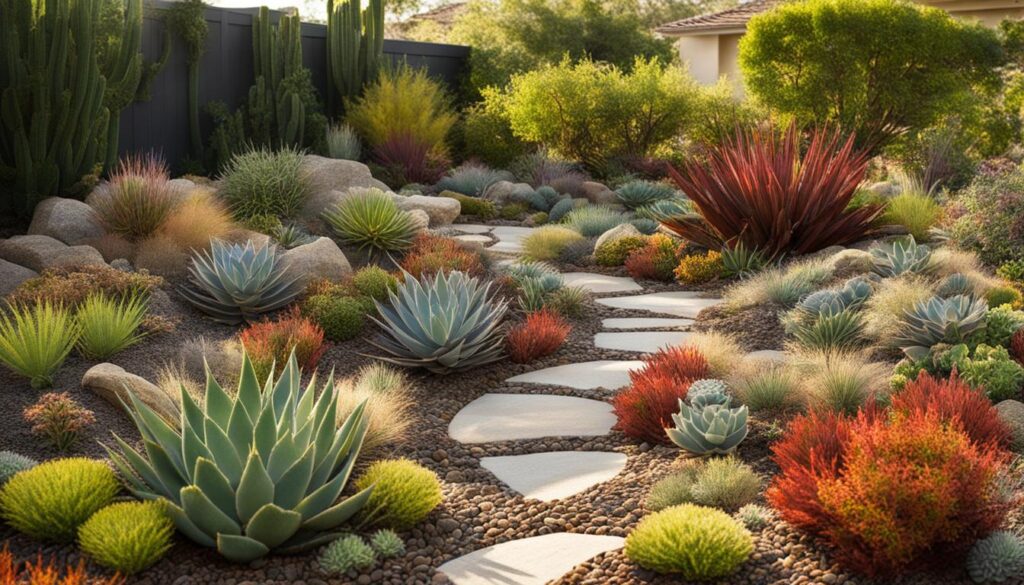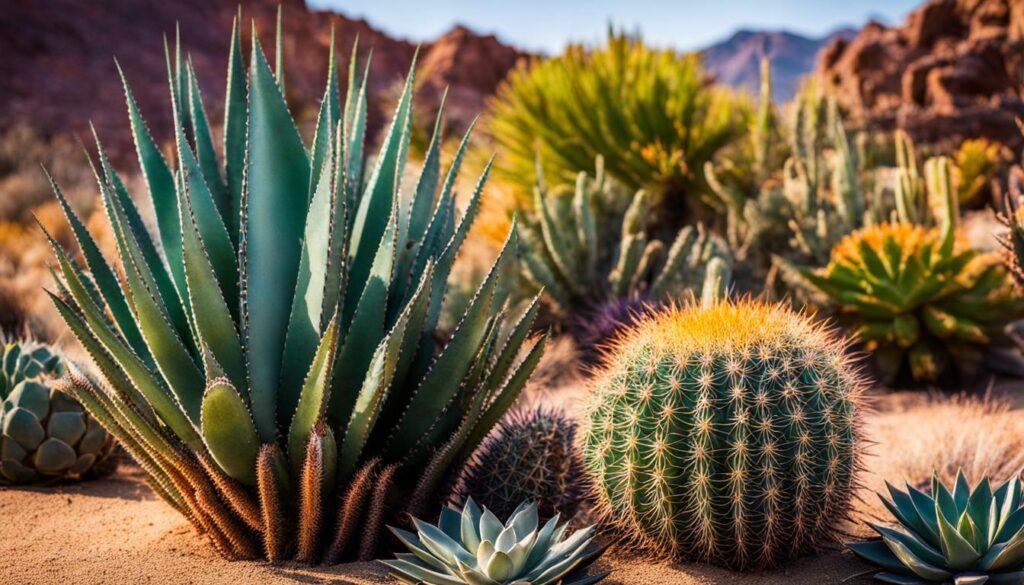Looking to create a beautiful garden while conserving water and lowering your bills? Embrace sustainable gardening with xeriscape principles! Xeriscaping is an eco-friendly gardening method that focuses on creating drought-resilient landscapes using minimal water.
By incorporating a mix of native grasses, flowers, shrubs, and trees, xeriscaping can save up to 60% on watering costs. But it’s not just about the savings – xeriscaping promotes biodiversity, reduces maintenance, and is environmentally friendly.
Key Takeaways:
- Xeriscape principles can help you create beautiful landscapes while conserving water.
- By using drought-resistant plants and efficient irrigation, xeriscaping can save up to 60% on watering costs.
- Xeriscaping promotes biodiversity and reduces maintenance requirements.
- Embracing sustainable gardening practices can contribute to a greener future.
- You can transform your landscape into a sustainable oasis with xeriscape principles.
What is Xeriscaping?
Xeriscaping is a gardening method that focuses on creating beautiful and vibrant landscapes while minimizing water usage. It involves the use of drought-tolerant plants and water-efficient irrigation systems, making it an ideal choice for homeowners who want to embrace sustainable gardening practices.
One of the key principles of xeriscaping is replacing traditional grassy lawns with native ground covers, mulch, or gravel. This helps to reduce the need for excessive watering and fertilizers, resulting in significant water conservation. By incorporating a mix of native grasses, flowers, shrubs, and trees, xeriscaping not only conserves water but also promotes biodiversity and creates a visually appealing landscape.
The use of water-efficient irrigation systems is another important aspect of xeriscaping. These systems can include drip irrigation, which delivers water directly to the plant’s root zone, minimizing waste through evaporation. By utilizing these methods, xeriscaping can help homeowners save water, lower their bills, and contribute to a more sustainable environment.
The key benefits of xeriscaping include:
- Water conservation: Xeriscaping can reduce water consumption by up to 60% compared to traditional landscapes.
- Biodiversity: By using native plants, xeriscaping creates habitats that support local wildlife.
- Low maintenance: Once established, xeriscapes require minimal watering, mowing, and fertilizing.
- Environmental friendliness: Xeriscaping reduces the need for chemical inputs, such as pesticides and fertilizers.
- Cost savings: By reducing water usage and maintenance needs, xeriscaping can lead to significant savings on water bills and long-term landscape upkeep.
In the next section, we will explore the various benefits of xeriscaping in more detail and learn how this sustainable gardening practice can transform your landscape into a water-wise and environmentally friendly oasis.
Benefits of Xeriscaping
Xeriscaping offers numerous benefits that make it an attractive choice for environmentally conscious homeowners. By implementing xeriscaping principles, you can achieve water conservation, promote biodiversity, enjoy low maintenance landscapes, contribute to an eco-friendly environment, and even save money in the long run.
Water conservation: One of the primary advantages of xeriscaping is its ability to significantly reduce water consumption. By utilizing drought-tolerant plants and implementing efficient irrigation methods, xeriscaping can help conserve water resources by up to 60%. This is particularly beneficial in regions prone to drought or water scarcity.
Biodiversity: Xeriscaping encourages the use of native plants, which not only thrive in the local climate but also support local wildlife and promote biodiversity. By creating diverse habitats, xeriscaping gardens become a haven for birds, butterflies, and other beneficial insects, contributing to the overall ecological balance of the area.
Low maintenance: Unlike traditional lawns, xeriscaping requires minimal maintenance once established. By selecting plants that are well-adapted to the local climate, you can reduce the need for watering, mowing, and fertilizing. This saves both time and effort, allowing you to enjoy your garden without spending hours on upkeep.
Environmentally friendly: Xeriscaping is an environmentally friendly gardening approach that reduces reliance on chemical inputs, such as pesticides and fertilizers. By using native plants that are naturally resistant to pests and diseases, you can minimize the need for harmful chemical treatments, ensuring a healthier and more sustainable environment for both humans and wildlife.
Cost savings: While there may be an initial investment in implementing xeriscaping, the long-term cost savings can be substantial. By reducing water consumption and eliminating the need for frequent lawn maintenance, xeriscaping can help lower water bills and save on landscaping expenses over time. This makes it an economically wise choice for homeowners looking to create beautiful and sustainable landscapes.
Key Benefits of Xeriscaping:
- Water conservation: Save up to 60% on water usage.
- Biodiversity: Support local wildlife and promote ecological balance.
- Low maintenance: Spend less time and effort on upkeep.
- Environmentally friendly: Reduce reliance on chemical inputs.
- Cost savings: Lower water bills and long-term maintenance expenses.
Principles of Xeriscaping
When it comes to creating a successful xeriscape garden, there are seven key principles that you should keep in mind. These principles will guide you in planning and designing your garden, ensuring efficient water usage, and promoting a healthy and sustainable landscape.
- Planning and Design: Before you begin, take the time to plan and design your xeriscape garden with a clear purpose in mind. Consider the layout, focal points, and the specific needs and preferences of your local climate.
- Soil Amendment: Testing and amending the soil is crucial to ensure proper drainage and nutrient availability for your plants. Add organic matter, such as compost, to improve soil structure and water retention.
- Efficient Irrigation: Implementing an efficient irrigation system is essential for xeriscaping. Consider using drip irrigation, which delivers water directly to the plant roots, minimizing water loss through evaporation. Install rain sensors or moisture-based controllers to adjust irrigation based on weather conditions.
- Mulching: Mulching is a key practice in xeriscaping as it helps conserve soil moisture, suppresses weed growth, and regulates soil temperature. Apply a layer of organic mulch around your plants, such as wood chips or straw, to reduce water evaporation and minimize maintenance requirements.
- Plant Selection: Choose plants that are well-adapted to your local climate and require minimal water once established. Consider native plants, as they are naturally suited to your area and promote biodiversity by attracting native wildlife.
- Grass Limitation: Limit the use of traditional grass lawns in your xeriscape garden. Instead, opt for low-water alternatives like ground covers, gravel, or native grasses. This reduces water consumption and maintenance needs while adding visual interest to your landscape.
- Regular Maintenance: Regular maintenance is crucial to keep your xeriscape garden thriving. Prune plants as needed, remove weeds, and monitor irrigation schedules to ensure optimal water usage. Taking care of your xeriscape garden will help it remain beautiful and sustainable over time.
By following these principles, you can create a xeriscape garden that is not only visually appealing but also environmentally friendly and water-efficient. Implementing efficient irrigation, using mulch, and selecting appropriate plants are just a few examples of how xeriscaping can transform your outdoor space into a sustainable oasis.
Leveraging the Principles to Create a Beautiful and Sustainable Landscape
The principles of xeriscaping provide a framework for designing and maintaining a beautiful and sustainable landscape. By applying these principles, you can achieve a balance between conserving water and creating an aesthetically pleasing outdoor space.
For example, proper planning and design allow you to create functional areas within your garden, such as seating areas or flower beds, while considering the water needs of different plants. Soil amendment ensures that your plants have a healthy foundation to grow, while efficient irrigation systems minimize water waste.
Mulching not only helps to retain moisture in the soil but also adds visual appeal to your garden and reduces weed growth. Carefully selecting plants based on their water requirements and limiting the use of traditional grass lawns help to conserve water and reduce maintenance needs.
Regular maintenance ensures that your xeriscape garden continues to thrive and remain sustainable over time. By following these principles, you can create a landscape that not only saves water but also enhances the beauty of your outdoor space.
Design Ideas for Xeriscaping
When it comes to xeriscaping, there are numerous design ideas that can turn your landscape into a sustainable oasis. From gravel and rock gardens to cactus gardens, rain gardens, prairie gardens, and xeriscape lawns, the options are diverse and visually appealing.
A gravel and rock garden is a popular choice for xeriscaping. It emulates natural rocks and provides a low-maintenance and water-efficient solution. By using various sizes and colors of gravel and incorporating strategically placed rocks, you can create an aesthetically pleasing and eco-friendly landscape.
Quote: “A gravel and rock garden is a popular choice for xeriscaping.”
If you prefer a desert-inspired landscape, a cactus garden might be the right choice for you. With their ability to thrive in arid conditions and their unique shapes and sizes, cacti can add a touch of beauty and intrigue to your xeriscape garden. Combine them with other drought-tolerant succulents for a stunning display.
Rain gardens are another excellent option for xeriscaping. These gardens are designed to collect and utilize rainwater, reducing the need for irrigation. By using native plants that can withstand both wet and dry periods, rain gardens not only conserve water but also provide a habitat for local wildlife.
Prairie gardens, filled with native grasses and wildflowers, showcase the beauty of the natural landscape while requiring minimal water. These gardens provide a haven for pollinators and offer a sustainable alternative to traditional lawns. The choice of native plants ensures that your garden thrives in the local climate.
Xeriscape lawns, created using low-water grasses, are an eco-friendly alternative to traditional lawns. These grasses have deep root systems that require less water and maintenance, making them ideal for water-conscious homeowners. Xeriscape lawns can be both visually appealing and sustainable, reducing water consumption and maintenance costs.
Summary:
- Gravel and rock gardens emulate natural rocks and require minimal maintenance.
- Cactus gardens showcase drought-tolerant succulents and add a unique touch to your landscape.
- Rain gardens collect and utilize rainwater, reducing the need for irrigation.
- Prairie gardens promote biodiversity with native grasses and wildflowers.
- Xeriscape lawns use low-water grasses, reducing water consumption and maintenance costs.
These design ideas for xeriscaping offer a range of choices to create a beautiful, sustainable, and water-wise landscape that reflects your personal style.
How Can Xeriscape Principles Help with Pest Management in Sustainable Gardening?
When practicing sustainable gardening, incorporating xeriscape pest management strategies is essential. Xeriscaping focuses on using drought-resistant plants and reducing water usage, which can also deter pest infestations. This xeriscape pest management strategies article offers valuable insights on how to implement these principles to maintain a healthy and pest-free garden.
Choosing Xeriscaping Plants
Choosing the right plants is a crucial step in creating a successful xeriscape garden. When selecting plants for xeriscaping, opt for drought-tolerant grasses, ground covers, shrubs, cacti and succulents, Mediterranean plants, and native plants that are well-adapted to your local climate. These plant varieties are naturally resilient to dry conditions and require less water, making them ideal for water-efficient landscaping.
Include drought-tolerant grasses in your xeriscape garden to add texture and color. Ornamental grasses like blue grama, buffalo grass, and feather reed grass are excellent options as they can withstand drought and require minimal maintenance. Ground covers such as creeping thyme, ice plant, and sedum are great choices for suppressing weeds and adding visual interest to your landscape.
Remember to choose plants that are well-suited to your specific climate and soil conditions. This will ensure their long-term survival and minimize the need for additional watering or soil amendments.
Shrubs are an essential element in xeriscape designs as they provide structure, habitat, and privacy. Opt for drought-tolerant shrubs like lavender, Russian sage, and yucca, which not only require less water but also attract pollinators and add beauty to your garden. Cacti and succulents, such as agave, aloe, and prickly pear, are perfect additions to xeriscape gardens due to their ability to store water in their leaves and adapt to arid conditions.
Consider incorporating Mediterranean plants like rosemary, lavender, and olive trees in your xeriscape garden for their aromatic scents and drought resistance. These plants thrive in climates with hot, dry summers and mild, wet winters, making them ideal for regions with Mediterranean-like conditions. Lastly, prioritize native plants as they are well-suited to the local environment, require minimal maintenance, and support local wildlife by providing food and shelter.
Soil improvement is another crucial aspect of xeriscaping. Before planting, amend your soil with organic matter like compost to improve its water-holding capacity and nutrient content. Well-draining soil is essential for the health and growth of xeriscape plants. Conduct a soil test to determine its composition and make necessary adjustments to create an optimal planting environment.
By choosing the right xeriscaping plants and improving your soil, you can create a beautiful, sustainable garden that thrives with minimal water consumption and maintenance.
Conclusion
Embrace sustainable gardening with xeriscape principles and discover the many benefits it offers. By incorporating water-wise practices and native plants, you can create an eco-friendly garden that is not only visually appealing but also helps conserve water and promote biodiversity.
Xeriscaping is a smart choice for those who value sustainable living. By following the core principles of xeriscaping, such as efficient irrigation and soil improvement, you can create a beautiful and low-maintenance landscape that is also cost-effective.
Take pride in your garden and contribute to a greener future by embracing xeriscaping. With this eco-friendly gardening approach, you can transform your landscape into a sustainable oasis and enjoy the benefits of a beautiful, thriving garden that supports the environment.






